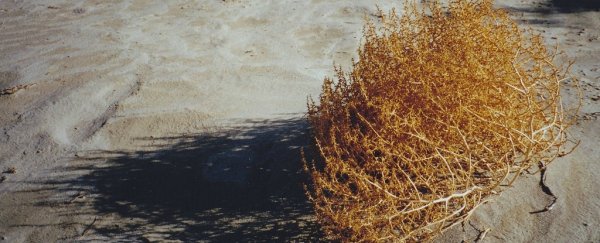Let's set the scene. It's high noon in a nondescript ghost town somewhere in the American West. Two men stand outside a saloon, about to duel to the death in the blistering sun. Moments before the two cowboys draw their weapons, a single, lonely tumbleweed bounces between them, summing up the entire setting with one arid plant.
While the tumbleweed has become a cliché of the American West in film, the reality is that they're actually quite dangerous, especially during a drought, because they can suddenly burst into flames and bounce around, causing an already out-of-control blaze to grow even larger. In fact, the problem is so bad in California, researchers have labelled them one of the worst invasive species in the region.
So how did all of this start? Well, despite the fact that the tumbleweed is primarily associated with America, the plant isn't native to the area in the least.
Instead, according to Sarah Zielinski for ScienceNews, the first species of American tumbleweed, Salsola tragus, came to the country in 1873 with Russian immigrants. Then, another species called S. australis somehow also arrived from Australia or South Africa.
To make matters worse, a new species of weed, S. ryanii, popped up in 2002, and this one combines chromosomes from the two other tumbleweed species. This suggests that the plant is adapting and breeding in its new American habitat just like any other invasive species.
And now, researchers from the University of Arizona and the University of California have confirmed that this new species is spreading way faster than previously thought.
According to their report, the team surveyed tumbleweed species at 53 Californian sites. In 2002, the year the new species was found, researchers found it at only two sites. But in 2012, the team found it at 15 sites.
So, in a decade, the plant has been steadily proliferating, which is no good in a state that's still suffering from a major drought, and is primed to ignite at any moment.
The researchers forecast that the tumbleweed problem will continue to spread at a rapid pace, with no signs of slowing down. While this isn't a problem that immediately threatens humans or the ecosystem, besides having the ability to carry wildfires from place to place, it's a prime example of how a species from a far off country can make its way against all odds to set up shop in another.
"Salsola ryanii has undergone a dramatic population number expansion in the decade since it was originally documented," the researchers report. "We are not aware of any plant neospecies whose range spontaneously experienced such a dramatic expansion. Salsola ryanii has every indication of being just as invasive as its highly invasive parents."
The team's full report was published in the American Journal of Botany.
